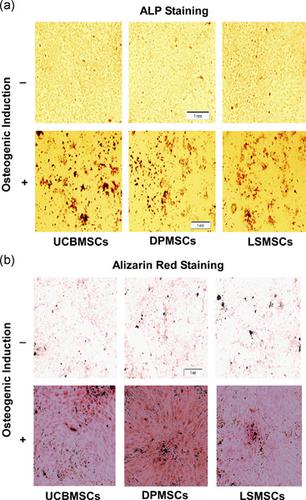当前位置:
X-MOL 学术
›
J. Cell. Physiol.
›
论文详情
Our official English website, www.x-mol.net, welcomes your feedback! (Note: you will need to create a separate account there.)
Cytokine physiognomies of MSCs from varied sources confirm the regenerative commitment post-coculture with activated neutrophils.
Journal of Cellular Physiology ( IF 5.6 ) Pub Date : 2020-05-09 , DOI: 10.1002/jcp.29713 Ahmed Al-Hakami 1, 2 , Saad Qaddah Alqhatani 3 , Sharaz Shaik 4 , Saaed Mohammed Jalfan 1 , Mohammed Saad Abu Dhammam 1 , Wejdan Asiri 1 , Abdullah Misfer Alkahtani 2 , Anantharam Devaraj 1, 2 , Harish C Chandramoorthy 1, 2
Journal of Cellular Physiology ( IF 5.6 ) Pub Date : 2020-05-09 , DOI: 10.1002/jcp.29713 Ahmed Al-Hakami 1, 2 , Saad Qaddah Alqhatani 3 , Sharaz Shaik 4 , Saaed Mohammed Jalfan 1 , Mohammed Saad Abu Dhammam 1 , Wejdan Asiri 1 , Abdullah Misfer Alkahtani 2 , Anantharam Devaraj 1, 2 , Harish C Chandramoorthy 1, 2
Affiliation

|
The interaction of mesenchymal stromal cells (MSCs) with paracrine signals and immunological cells, and their responses and regenerative commitment thereafter, is understudied. In the current investigation, we compared MSCs from the umbilical cord blood (UCB), dental pulp (DP), and liposuction material (LS) on their ability to respond to activated neutrophils. Cytokine profiling (interleukin‐1α [IL‐1α], IL‐2, IL‐4, IL‐6, IL‐8, tumor necrosis factor‐α [TNF‐α], interferon‐γ [IFN‐γ], transforming growth factor‐β [TGF‐β]), cellular proliferation and osteogenic differentiation patterns were assessed. The results showed largely comparable cytokine profiles with higher TNF‐α and IFN‐γ levels in LSMSCs owing to their mature cellular phenotype. The viability and proliferation between LS/DP/UCB MSCs were comparable in the coculture group, while direct activation of MSCs with lipopolysaccharide (LPS) showed comparable proliferation with significant cell death in UCB MSCs and slightly higher cell death in the other two types of MSC. Furthermore, when MSCs post‐neutrophil exposure were induced for osteogenic differentiation, though all the MSCs devoid of the sources differentiated, we observed rapid and significant turnover of DPMSCs positive of osteogenic markers rather than LS and UCB MSCs. We further observed a significant turnover of IL‐1α and TGF‐β at mRNA and cytokine levels, indicating the commitment of MSCs to differentiate through interacting with immunological cells or bacterial products like neutrophils or LPS, respectively. Taken together, these results suggest that MSCs have more or less similar cytokine responses devoid of their anatomical niche. They readily switch over from the cytokine responsive cell phenotype at the immunological microenvironment to differentiate and regenerate tissue in response to cellular signals.
中文翻译:

来自多种来源的MSC的细胞因子生理学证实了与活化的中性粒细胞共培养后的再生承诺。
间充质基质细胞(MSCs)与旁分泌信号和免疫细胞的相互作用,以及它们的反应和此后的再生承诺,都得到了研究。在当前的研究中,我们比较了来自脐带血(UCB),牙髓(DP)和吸脂材料(LS)的MSC对活化的中性粒细胞的反应能力。细胞因子分析(白介素-1α[IL-1α],IL-2,IL-4,IL-6,IL-8,肿瘤坏死因子-α[TNF-α],干扰素-γ[IFN-γ],转化生长因子-β[TGF-β]),细胞增殖和成骨分化模式进行了评估。结果显示,由于其成熟的细胞表型,LSMSC中具有较高TNF-α和IFN-γ水平的细胞因子谱可比。在共培养组中,LS / DP / UCB MSC之间的生存力和增殖相当,而用脂多糖(LPS)直接激活MSC则显示出可比的增殖,在UCB MSC中细胞死亡明显,而在其他两种类型的MSC中细胞死亡略高。此外,当诱导中性粒细胞暴露后的MSC进行成骨分化时,尽管所有MSC都没有分化来源,但我们观察到成骨标记阳性的DPMSC的快速且显着的周转,而不是LS和UCB MSC。我们进一步观察到在mRNA和细胞因子水平上IL-1α和TGF-β的大量转换,表明MSC致力于通过分别与免疫细胞或细菌产物(如中性粒细胞或LPS)相互作用来分化。综上所述,这些结果表明,MSC具有或多或少的相似的细胞因子应答,而没有它们的解剖位置。
更新日期:2020-05-09
中文翻译:

来自多种来源的MSC的细胞因子生理学证实了与活化的中性粒细胞共培养后的再生承诺。
间充质基质细胞(MSCs)与旁分泌信号和免疫细胞的相互作用,以及它们的反应和此后的再生承诺,都得到了研究。在当前的研究中,我们比较了来自脐带血(UCB),牙髓(DP)和吸脂材料(LS)的MSC对活化的中性粒细胞的反应能力。细胞因子分析(白介素-1α[IL-1α],IL-2,IL-4,IL-6,IL-8,肿瘤坏死因子-α[TNF-α],干扰素-γ[IFN-γ],转化生长因子-β[TGF-β]),细胞增殖和成骨分化模式进行了评估。结果显示,由于其成熟的细胞表型,LSMSC中具有较高TNF-α和IFN-γ水平的细胞因子谱可比。在共培养组中,LS / DP / UCB MSC之间的生存力和增殖相当,而用脂多糖(LPS)直接激活MSC则显示出可比的增殖,在UCB MSC中细胞死亡明显,而在其他两种类型的MSC中细胞死亡略高。此外,当诱导中性粒细胞暴露后的MSC进行成骨分化时,尽管所有MSC都没有分化来源,但我们观察到成骨标记阳性的DPMSC的快速且显着的周转,而不是LS和UCB MSC。我们进一步观察到在mRNA和细胞因子水平上IL-1α和TGF-β的大量转换,表明MSC致力于通过分别与免疫细胞或细菌产物(如中性粒细胞或LPS)相互作用来分化。综上所述,这些结果表明,MSC具有或多或少的相似的细胞因子应答,而没有它们的解剖位置。



























 京公网安备 11010802027423号
京公网安备 11010802027423号